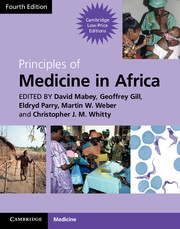Book contents
- Frontmatter
- Contents
- Contributors
- Foreword
- Section 1 Health and disease
- Section 2 Mother and child health
- Section 3 Infection: general principles
- Section 4 Major common infections
- Section 5 Bacterial infections
- Section 6 Viral Infections
- Section 7 Protozoal infections
- Section 8 Helminth infections
- Section 9 Fungal infections
- Section 10 Non-communicable diseases
- 56 Chronic and non-communicable disease in Africa
- 57 Chronic non-communicable disease in health care
- 58 Diabetes mellitus
- 59 Hypertension
- 60 Stroke
- 61 Epilepsy
- 62 Mental health
- 63 Asthma, chronic obstructive pulmonary disease (COPD) and exposure to indoor air pollution
- 64 The disabled patient
- Section 11 Diseases of body systems
- Section 12 Cancer and Palliative Care
- Section 13 Venoms and Poisons
- Index
- References
60 - Stroke
from Section 10 - Non-communicable diseases
Published online by Cambridge University Press: 05 March 2013
- Frontmatter
- Contents
- Contributors
- Foreword
- Section 1 Health and disease
- Section 2 Mother and child health
- Section 3 Infection: general principles
- Section 4 Major common infections
- Section 5 Bacterial infections
- Section 6 Viral Infections
- Section 7 Protozoal infections
- Section 8 Helminth infections
- Section 9 Fungal infections
- Section 10 Non-communicable diseases
- 56 Chronic and non-communicable disease in Africa
- 57 Chronic non-communicable disease in health care
- 58 Diabetes mellitus
- 59 Hypertension
- 60 Stroke
- 61 Epilepsy
- 62 Mental health
- 63 Asthma, chronic obstructive pulmonary disease (COPD) and exposure to indoor air pollution
- 64 The disabled patient
- Section 11 Diseases of body systems
- Section 12 Cancer and Palliative Care
- Section 13 Venoms and Poisons
- Index
- References
Summary
Increasing population age and vascular risk factors in Africa are causing an increased burden of stroke and stroke-related disability and mortality. There are three pathological stroke types: ischaemic stroke, cerebral haemorrhage and subarachnoid haemorrhage. Each of these stroke types is the result of specific causes and risk factors or combinations of risk factors, and their treatment differs. However, while subarachnoid haemorrhage is usually readily distinguishable from the other two types, it is not easy to distinguish ischaemic stroke and cerebral haemorrhage without brain imaging. This highlights one of the key challenges to managing stroke in Africa, where very few patients have access to brain imaging. Local resources influence stroke management in Africa, but basic principles of stroke care are as important in low- as they are in high-resourced settings.
The problem in Africa
There are only isolated reports of stroke in Africa in the literature from the early 1900s. Indeed, clinicians working in Africa commented on how little stroke they saw in practice. This has rapidly changed over the last few decades (Connor et al., 2007). The most accurate assessment of stroke in a population comes from community-based stroke incidence studies adhering to criteria for the ‘ideal’ study. Unfortunately, no ‘ideal’ studies have been performed in Africa. Despite this, there is evidence from prevalence and mortality studies to suggest that stroke burden is already significant and increasing. Two community-based stroke prevalence studies found that there were twice as many stroke patients in rural South Africa as in Tanzania, but half as many in South Africa as in a typical high-income population (New Zealand) (Walker et al., 2000; Connor et al., 2004). Case fatality in Africa appears to be higher than in high-income regions (around 30 per cent compared with around 20 per cent).
- Type
- Chapter
- Information
- Principles of Medicine in Africa , pp. 524 - 530Publisher: Cambridge University PressPrint publication year: 2013



